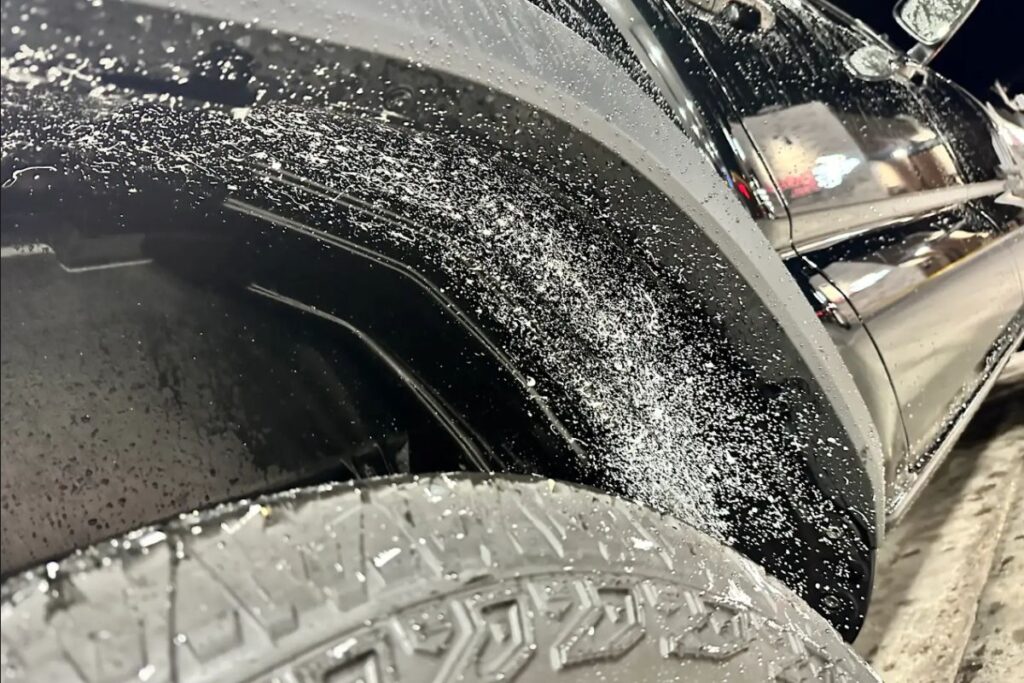As winter approaches, car owners often face the daunting challenge of protecting their vehicles from the harsh elements. Snow, ice, and freezing temperatures can damage your car’s exterior. However, there’s a high-tech solution gaining traction: ceramic coatings. In this blog, we will explore how ceramic coatings shield your car during winter and whether they can be applied in cold weather.
What challenges does winter pose to car exteriors?
Winter presents several challenges to car exteriors, which can lead to long-term damage if not properly addressed. Here are some of the main challenges:
- Road salt: Used to melt ice on roads, road salt is highly corrosive and can lead to rust and deterioration of a car’s paint, metal, and undercarriage.
- Moisture and snow: Snow and moisture can seep into small cracks and crevices in the car’s paint, leading to rust and corrosion over time, especially when temperatures fluctuate causing ice to melt and refreeze.
- Freezing temperatures: Cold weather can cause the car’s exterior materials to contract, leading to potential cracks in the paint or other surfaces. Temperature changes can also make your car more susceptible to chips and scratches.
- UV rays: Even in winter, UV rays can still damage the car’s paint by causing fading and oxidation, especially on sunny, snowy days when sunlight is reflected off surfaces.
- Debris and ice scraping: Snow, ice, and debris can stick to the car’s surface. Hard scraping off ice or snow can cause scratches and damage to the paintwork if done too aggressively.
- Mud and dirt buildup: Mud, dirt, and road grime are more prevalent during winter. They can stick to the car’s surface, dulling the finish and making it more difficult to clean.

Winter presents several challenges to your car
How ceramic coatings protect your car in cold weather
Ceramic coatings help shield your car’s paintwork by creating a tough, invisible barrier that can withstand the worst that winter has to offer.
Defense against road salt
Road salt is necessary for melting ice, but it’s extremely corrosive to your car’s exterior. Ceramic coatings act as a barrier, preventing salt from penetrating your car’s paint and minimizing damage and corrosion.
Read more: Best vehicle tint shop near me in Cape Girardeau, MO
Protection against snow and ice
One of the major benefits of ceramic coatings in cold weather is their ability to prevent snow and ice from sticking to your car’s surface. The coating’s hydrophobic nature means that water beads up and rolls off, taking contaminants with it. You can quickly clear snow and ice from your car, reducing the risk of scratches when you have to scrape off stubborn ice.
UV protection even in winter
Though winter is often gloomy, UV rays are still present and can cause your car’s paint to fade over time. Ceramic coatings provide a layer of protection against UV damage, ensuring your car’s paint remains vibrant, even on winter days.
Easy cleaning
Keeping your car clean in winter is extremely difficult. With ceramic coatings, washing your vehicle becomes a breeze, even in freezing temperatures. Since contaminants such as mud, slush, and salt are less likely to stick to your car’s surface, a simple rinse is often enough to keep your vehicle looking its best.
Difficulties when applying ceramic coatings during winter
Applying ceramic coatings in cold weather presents several challenges:
- Temperature sensitivity: Ceramic coatings require specific temperature ranges to cure effectively (between 10°C and 25°C). In cold conditions, the curing process slows down, potentially affecting the coating’s durability and performance.
- Application difficulties: Cold weather can make the coating more viscous, leading to uneven application and coverage challenges.
- Environmental factors: High humidity and moisture from snow or frost can interfere with the bonding process, impacting the coating’s effectiveness.
- Surface preparation: Freezing temperatures can complicate surface cleaning and preparation, crucial for a successful application.

Applying ceramic coatings in freezing temperatures can be tricky
Tips for successfully applying ceramic coatings in cold weather
If you’re considering applying ceramic coatings to your vehicle during cold weather, it’s crucial to understand that lower temperatures can significantly impact the coating’s effectiveness.
To ensure the coating is applied correctly and performs optimally, it’s best to seek the expertise of professional detailers like Cloud 9 Tint Studio and Auto Spa. Our specialists have the experience, equipment, and controlled environments necessary to apply the coating effectively.
Related: Does Ceramic Window Tinting Apply To All Windows In Homes, Cars, Boats, And Businesses?
Moreover, the best time to have ceramic coatings done is now, as soon as possible, before the full onset of winter. It ensures your vehicle is well-protected when temperatures drop.
Protect your car from the cold with ceramic coatings service by Cloud 9 Tint Studio and Auto Spa
Shield your vehicle from harsh winter conditions with professional ceramic coatings services from Cloud 9 Tint Studio and Auto Spa. Our high-quality ceramic coatings provide a durable barrier against road salt, ice, and freezing temperatures, preserving your car’s exterior and paintwork during the cold months.
Stop by South West St, Perryville, MO 63775, or call us at 573-570-4470 – 573-768-2721 to schedule your winter protection service today! Don’t wait until it’s too late!
